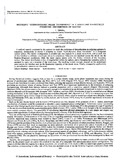Modeling "hydrodynamic phase transitions" in a radiating spherically symmetric distribution of matter
Date
2005-12-08Palabras Clave
Distribuciones autogravitantes, AstrofísicaDense matter, Hydrodynamics, Shock waves, Stars: neutrons, Astrophysics, Astronomical models, Gravitational collapse, Magnetohydrodynamics, Mass distribution, Phase transformations, Condensed matter physics, Magnetohydrodynamic waves, Neutron stars, Supernovae
Metadata
Show full item recordAbstract
Modeling "hydrodynamic phase transitions" in a radiating spherically symmetric distribution of matter
(Herrera, L.; Núñez, Luis)
Abstract
A method recently proposed by the authors to study the evolution of discontinuities in radiating spherically symmetric distributions of matter is extended to model "hydrodynamic phase transitions " in a composite radiant sphere. The matter configuration is divided into two regions by a shock wave front, and at each side of this interface a different anisotropic phase is considered. Solutions are matched across the shock via the Rankine-Hugoniot conditions, while the outer region metric joins the Vaidya solution at the boundary surface. The matter distribution is free of singularities within the sphere, and a Gaussian-like radiation pulse is assumed to carry out a fraction of the total mass. The resulting models strongly depend on the anisotropic jump across the interface and on the luminosity (opacity) of the shock wave. Finally, prospective applications to astrophysical scenarios are discussed.
Artículo publicado en: The Astrophysical Journal, 339: 339-353,1989 April 1
Collections
Información Adicional
| Correo Electrónico | laherrera@telcel.net.ve nunez@ula.ve |
| Editor | SABER ULA |






